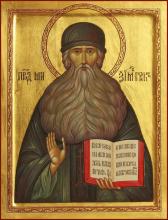21 June / 4 July
 Venerable St. Maximus the Greek (15th - 16th C.), the son of a wealthy Greek official in the town of Arta, Albania, had an outstanding education. As a youth, he traveled extensively, and studied in European lands - spending time in Paris, Florence, and Venice. Upon returning to his homeland, he went to Mt. Athos, where he was tonsured a monk at the Vatopedi Monastery. He was fascinated by, and studied the ancient manuscripts left by Greek Emperors (Andronicus Paleologos and John Cantacuzene) who spent time in monastic seclusion on Mt. Athos. At this time, Great Prince Vasily Ioannovitch of Moscow (1505 - 1533) decided to investigate his mother’s (Sophia Paleologos’) Greek manuscripts and books. He asked the Patriarch of Constantinople to send him a learned Greek. Monk Maximus was ordered to Moscow. Upon his arrival, he was assigned to translate into Slavonic a commentary on the Psalter, a commentary on the Acts of the Apostles, and several books of Church services. St. Maximus assiduously and carefully strove to complete all of his assigned tasks. However, as Slavonic was not the translator’s native language, his translations naturally contained some inaccuracies.
Venerable St. Maximus the Greek (15th - 16th C.), the son of a wealthy Greek official in the town of Arta, Albania, had an outstanding education. As a youth, he traveled extensively, and studied in European lands - spending time in Paris, Florence, and Venice. Upon returning to his homeland, he went to Mt. Athos, where he was tonsured a monk at the Vatopedi Monastery. He was fascinated by, and studied the ancient manuscripts left by Greek Emperors (Andronicus Paleologos and John Cantacuzene) who spent time in monastic seclusion on Mt. Athos. At this time, Great Prince Vasily Ioannovitch of Moscow (1505 - 1533) decided to investigate his mother’s (Sophia Paleologos’) Greek manuscripts and books. He asked the Patriarch of Constantinople to send him a learned Greek. Monk Maximus was ordered to Moscow. Upon his arrival, he was assigned to translate into Slavonic a commentary on the Psalter, a commentary on the Acts of the Apostles, and several books of Church services. St. Maximus assiduously and carefully strove to complete all of his assigned tasks. However, as Slavonic was not the translator’s native language, his translations naturally contained some inaccuracies.
Metropolitan Varlaam greatly valued St. Maximus’ efforts. When Metropolitan Daniel ascended the Moscow Metropolia throne, things changed. The new Metropolitan demanded that St. Maximus translate Theodorite’s church history into Slavonic. Maximus the Greed adamantly refused that assignment, noting that “this history includes the letters of the schismatic Arius, and that may imperil its clarity.” That refusal sowed discord between the Venerable One and the Metropolitan. Despite the friction, St. Maximus continued to zealously work in the fields of spiritual enlightenment of Rus.’ He wrote epistles directed against the Muslims, Papists, and pagans. He translated St. John Chrysostom’s commentaries on the Gospel according to Matthew and John, and also wrote several compositions of his own.
When the Great Prince was planning to dissolve his marriage to his wife Solomonea on the grounds that she was barren, the courageous Confessor Maximus wrote to the prince, “Instructive chapters to the right-believing authorities,” in which he convincingly demonstrated that the Great Prince’s position dictated that he not succumb to animal passions. St. Maximus was cast into prison. At that point, a new period in the Venerable One’s life, a time of great suffering, began. Inaccuracies were discovered in St. Maximus’ translations, and he was blamed for intentionally corrupting the texts.
Life in prison was difficult for the Venerable One, but amid his sufferings, he also experienced God’s great mercy and kindness: An angel appeared to him and said, “Persevere, O Elder! Through these trials you will avoid eternal suffering.” The Venerable Elder used charcoal to write on the prison wall the canon to the Holy Spirit which to this day is chanted in the Church: “O Thou Who of old in the desert didst feed Israel with manna, do also, O Lord, fill my soul with the All-holy Spirit, that for It I might ever serve in a manner pleasing to Thee...”
Six years later, St. Maximus was released and placed under church ban in Tver. There he lived under the supervision of the Bishop Akakios, a generous soul who treated kindly one who had been subjected to suffering without cause. The Saint wrote an autobiographical work, “Thoughts with which a mournful monk, locked up in prison, consoled and strengthened himself to patiently persevere.” Here are a few words from this glorious composition, “Do not grieve, do not mourn, and do not be anguished, o loving soul, over your unjust sufferings, all of which you should rather accept as good, for you have used them spiritually, offering them the banquet prepared by and filled with the Holy Spirit...” It was only after 20 years in Tver that the Saint was allowed to live in freedom, and not under church ban. St. Maximus the Greek spent his final years in the Holy Trinity-St. Sergius Lavra. He was by then almost 70 years old. The persecutions and labors to which he had been subjected affected his health, but his spirit remained hale, and he continued to work. With his cell attendant and disciple Nilus, the Venerable One assiduously continued to translate the Psalter from Greek into Slavonic. Neither persecution nor incarceration could break St. Maximus.
The Venerable Saint reposed on January 21, 1556. He was interred near the Northwest wall of the Church of the Holy Spirit in the Holy Trinity - St. Sergius Lavra. Many grace-filled events taking place before the Saint’s tomb have been documented. The troparion and kontakion to the Saint are inscribed on his tomb.
